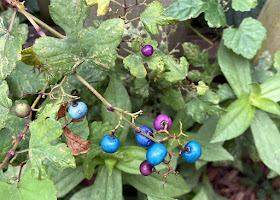Originally published July 3, 1999 in Canton Daily Ledger
I enjoyed talking to many of you last Saturday at the Canton and Farmington Garden Walks. The response to the walks was overwhelming. Thank you to the garden owners for sharing their beautiful gardens with us. I know you all worked hard to prepare, and the results were just spectacular. Mostly I want to thank the two Master Gardeners who did all the preparatory work: Judy Hollaway and John Taylor.
All the gardens had something to offer and I learned
something at each location. What really struck me, though, were the number of
vines and their uses. When used properly, vines really catch the eye by adding
a new dimension to the garden.
Also, at the Meade residence was the unique and somewhat
rare Arctic Beauty Kiwi (Actinidia kolomikta). This particular
Actinidia has uniquely decorated leaves. They are pink at the tip, white in the
middle, and green at the base. The White Flower Farm catalog indicates that they
“offer male plants only, because they have the best coloring and note that leaf
color takes a year or two to develop.”
Several locations displayed the Mandevilla (Mandevilla
x amabilis) vine. This woody twiner has large showy pink flowers and
blooms in profusion over long periods. The dark green, glossy leaves are also
attractive.
Wisteria flowers are outstanding and often fragrant. As an
added bonus, the twisted woody trunks add character to the garden. Wisteria is
easy to grow, but sometimes difficult to get to bloom. The reasons vary
including too much nitrogen, winter injury, and the need for pruning. Too much
nitrogen promotes excess vegetative growth and few flowers. Sometimes it helps
to cut vigorous growth back to 3 or 4 buds since some species bloom on the current
season’s growth. It is also usually advisable to use named cultivars rather
than seedling-grown material.


No comments:
Post a Comment